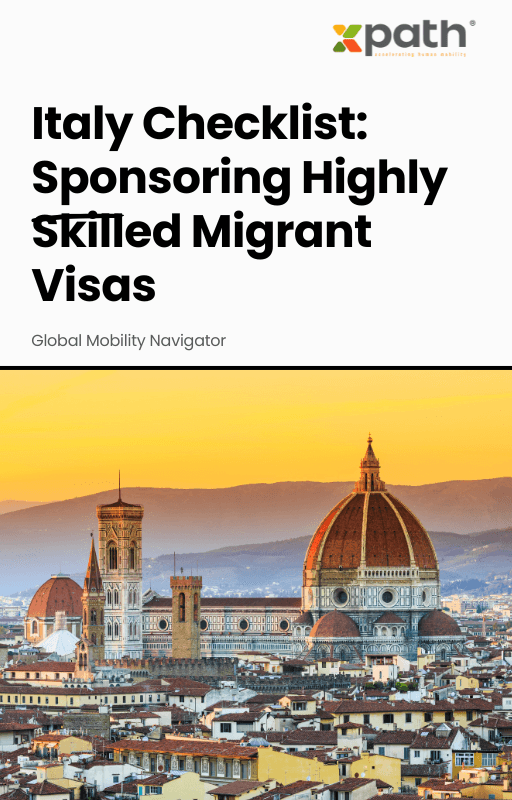Italy Checklist: Sponsoring Highly Skilled Migrant Visas
Grab a copy of a guide to international employee relocation
View E-bookThe employee relocation process isn’t just about new opportunities—it’s also about the delicate art of crafting a seamless experience for assignees. Today’s global workforce expects more than a ticket and a checklist; they crave a smooth, supportive journey from their home base to wherever their talents take them. If you’re responsible for the success of international assignments, mastering the art of the assignee experience can transform your global mobility solution from a painful process into a powerful perk. So, what does it really take to deliver a frictionless transition, and why does it matter more than ever? Let’s dive in.
Think about it: every relocation represents both a risk and an investment for businesses and their people. A positive mobility experience can turn assignees into lifelong advocates, while a rocky one can lead to distraction, disengagement, or even failed assignments. According to a 2023 report by Deloitte, companies with high employee satisfaction in global mobility programs see a 40% increase in assignment success and retention. In a world where the competition for top-level talent is fierce, the relocation experience can be a game-changer in attracting and retaining your best people. The emotional impact is real—relocation anxiety can reduce productivity by up to 25% in the first six months, yet firms that provide holistic, tech-enabled support see adaptation times shrink significantly.
Global mobility solutions have evolved dramatically. Gone are the days of manual spreadsheets and ambiguous handbooks. Now, organizations rely on sophisticated platforms—think xpath.global and its alternatives—that integrate every touchpoint of the relocation cycle, from immigration to settling-in services.
It isn’t just about handling visas anymore. Companies must navigate tax compliance, cultural integration, benefits harmonization, and ongoing support. A data-driven approach is now the baseline: 72% of global organizations (PwC 2023) are investing in digital transformation for their mobility programs, aiming for visibility, real-time collaboration, and reduced administrative burden. The goal? Anticipate obstacles and smooth them over before assignees even feel them.
Modern mobility comes with its hurdles. The biggest friction points? Unclear communication, lack of personalization, and gaps between policy and reality. Let’s put that into perspective: a KPMG survey found that 53% of assignees list “uncertainty about next steps” as their top stressor, followed closely by confusion about local compliance and insufficient family support. Even with robust policies, when employees face labyrinthine relocation processes or inconsistent points of contact, frustration mounts.
Another challenge: scalability. As the volume and diversity of assignments rise, traditional high-touch models struggle to keep up. That’s where automation and integrated digital platforms step in—solutions like xpath.global enable personalization and consistency at scale, ensuring every assignee feels valued, not lost in the crowd.
Let’s look at two real-world examples that illustrate seamless mobility in action. First, a Fortune 500 tech company partnered with xpath.global to overhaul its assignee experience. By consolidating over 15 relocation vendors onto one smart platform, the company reduced time-to-assignment by 38 days and cut compliance errors by 62%. The icing on the cake? Assignee satisfaction scores jumped from 6.4 to 9.1 in a single year.
In another case, a mid-sized consultancy relied on data analytics to spot patterns in support requests. With targeted resources for high-touch moments—think pre-departure briefings, spouse employment assistance, and local networking events—the company was able to halve attrition rates for international placements while fostering a culture of trust.
How can you replicate these successes? Start with high-impact communication. Transparent timelines, interactive FAQs, and regular updates go a long way. Think of your process as a “concierge service,” not a transactional checklist—offer digital welcome kits, assign dedicated mobility managers, and encourage two-way feedback every step of the way.
Don’t forget about families and accompanying partners. Relocation is a family affair; the more you support their needs—schooling, cultural adaptation, social integration—the smoother everyone’s journey. And, leverage technology not just for oversight, but for empathy: chatbots for quick answers, AI-driven personalization, and mobile-first platforms keep everything at an assignee’s fingertips.
The future of mobility solutions is all about blending digital agility with genuine care. We’re seeing a shift toward self-service portals, app-based travel support, and even wellness resources embedded into the relocation process. A recent Mercer mobility study notes that 88% of leading organizations now offer digital tracking for all tasks—yet they pair this with proactive, human-centered outreach. Think interactive city tours, mentorship pairings, and personalized onboarding to foster a sense of belonging from day one.
xpath.global, for example, empowers companies to orchestrate these moving parts effortlessly, reducing administrative headaches while empowering employees to take charge of their journey with confidence. Their all-in-one platform means no detail (no matter how small) gets left behind.
In the end, the goal isn’t just to move employees—it’s to move their lives, ambitions, and sense of belonging. A seamless assignee experience pays dividends in productivity, retention, and loyalty. It’s a strategic investment in your global future. Ready to set a new standard for mobility in your organization? Now’s the time to act.
What is a global mobility solution?
A global mobility solution combines software, services, and policies to help organizations relocate and support employees internationally—covering immigration, tax, housing, onboarding, and compliance.
Why is the assignee experience important?
A positive experience reduces stress, boosts assignment success, and supports retention. A negative one can lead to early repatriation and talent loss.
How can technology improve relocation?
Platforms like xpath.global streamline data, automate tasks, provide real-time updates, and personalize services—making assignments smoother and more predictable.
What can companies do to support accompanying families?
Offer school search assistance, spousal job support, cultural integration services, and local community resources—ensuring the whole family feels at home.
How do I measure assignee satisfaction?
Track feedback at key moments (pre-departure, arrival, 90 days in), monitor retention and productivity data, and benchmark experience scores over time.
Ready to transform your mobility program? Explore xpath.global’s solutions.

Italy Checklist: Sponsoring Highly Skilled Migrant Visas
Grab a copy of a guide to international employee relocation
View E-book